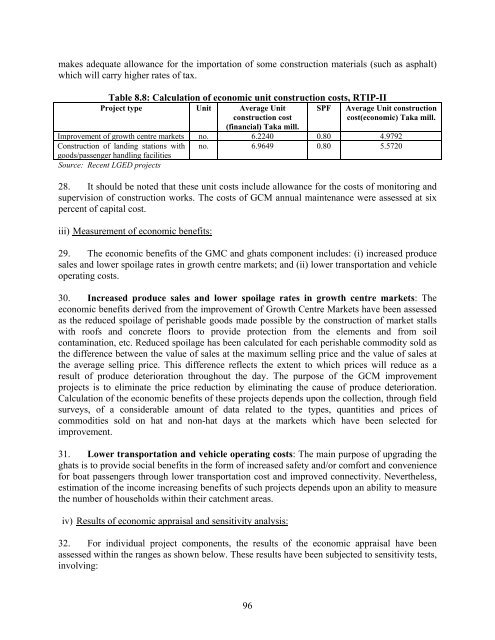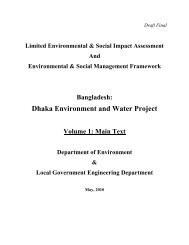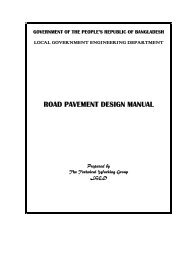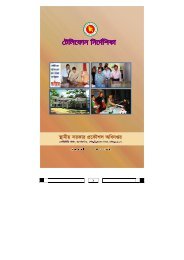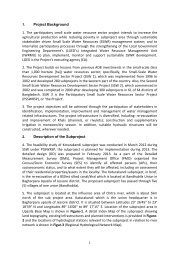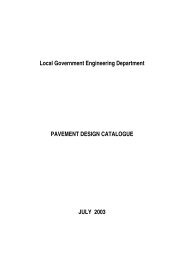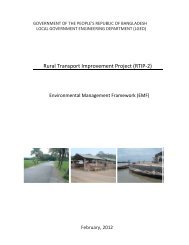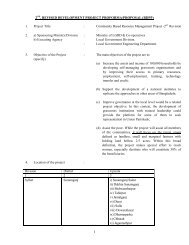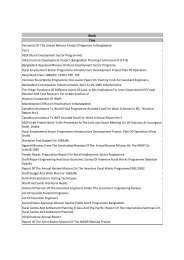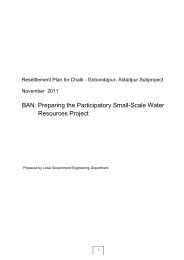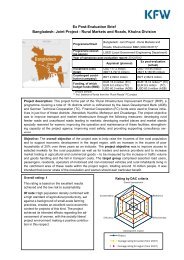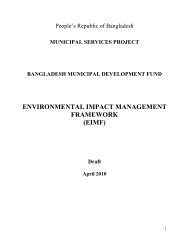PAD - LGED
PAD - LGED
PAD - LGED
You also want an ePaper? Increase the reach of your titles
YUMPU automatically turns print PDFs into web optimized ePapers that Google loves.
makes adequate allowance for the importation of some construction materials (such as asphalt)<br />
which will carry higher rates of tax.<br />
Table 8.8: Calculation of economic unit construction costs, RTIP-II<br />
Project type Unit Average Unit<br />
construction cost<br />
SPF Average Unit construction<br />
cost(economic) Taka mill.<br />
(financial) Taka mill.<br />
Improvement of growth centre markets no. 6.2240 0.80 4.9792<br />
Construction of landing stations with no. 6.9649 0.80 5.5720<br />
goods/passenger handling facilities<br />
Source: Recent <strong>LGED</strong> projects<br />
28. It should be noted that these unit costs include allowance for the costs of monitoring and<br />
supervision of construction works. The costs of GCM annual maintenance were assessed at six<br />
percent of capital cost.<br />
iii) Measurement of economic benefits:<br />
29. The economic benefits of the GMC and ghats component includes: (i) increased produce<br />
sales and lower spoilage rates in growth centre markets; and (ii) lower transportation and vehicle<br />
operating costs.<br />
30. Increased produce sales and lower spoilage rates in growth centre markets: The<br />
economic benefits derived from the improvement of Growth Centre Markets have been assessed<br />
as the reduced spoilage of perishable goods made possible by the construction of market stalls<br />
with roofs and concrete floors to provide protection from the elements and from soil<br />
contamination, etc. Reduced spoilage has been calculated for each perishable commodity sold as<br />
the difference between the value of sales at the maximum selling price and the value of sales at<br />
the average selling price. This difference reflects the extent to which prices will reduce as a<br />
result of produce deterioration throughout the day. The purpose of the GCM improvement<br />
projects is to eliminate the price reduction by eliminating the cause of produce deterioration.<br />
Calculation of the economic benefits of these projects depends upon the collection, through field<br />
surveys, of a considerable amount of data related to the types, quantities and prices of<br />
commodities sold on hat and non-hat days at the markets which have been selected for<br />
improvement.<br />
31. Lower transportation and vehicle operating costs: The main purpose of upgrading the<br />
ghats is to provide social benefits in the form of increased safety and/or comfort and convenience<br />
for boat passengers through lower transportation cost and improved connectivity. Nevertheless,<br />
estimation of the income increasing benefits of such projects depends upon an ability to measure<br />
the number of households within their catchment areas.<br />
iv) Results of economic appraisal and sensitivity analysis:<br />
32. For individual project components, the results of the economic appraisal have been<br />
assessed within the ranges as shown below. These results have been subjected to sensitivity tests,<br />
involving:<br />
96


